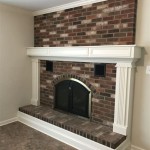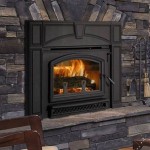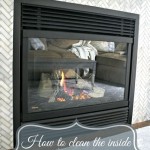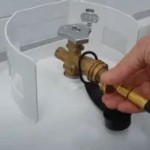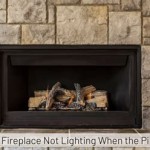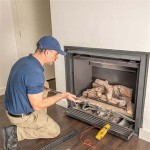The Enduring Appeal of Fireplace Mantels: Design, Function, and History
Fireplace mantels have served as focal points in homes for centuries, evolving from purely functional necessities to elaborate decorative elements. These architectural features, typically surrounding a fireplace opening, contribute significantly to the aesthetic of a room while often providing practical storage and display space. Understanding the history, design considerations, and functional aspects of fireplace mantels allows homeowners to make informed decisions when selecting or renovating this important feature.
The primary function of an early mantel was to redirect smoke away from the interior of a dwelling. Before the advent of engineered chimneys, fireplaces were often open hearths, prone to releasing smoke and ash into the living space. The mantel, acting as a hood or projection above the fire, helped to channel the smoke upwards into the flue, improving indoor air quality and reducing the risk of fire. Over time, as chimney designs improved, the functional necessity of the mantel shifted, and its decorative potential became increasingly emphasized.
Today, fireplace mantels are available in a vast range of materials, styles, and sizes, catering to diverse architectural preferences and interior design schemes. From rustic wood beams to sleek modern designs, the mantel serves as a visual anchor, drawing the eye and defining the character of the fireplace area. Selecting the appropriate mantel requires careful consideration of the fireplace itself, the overall room decor, and the desired aesthetic impact.
Evolution of Mantel Design and Materials
The design of fireplace mantels has mirrored stylistic trends throughout history. Early mantels were often simple, constructed from readily available materials like wood or stone. As craftsmanship advanced, mantels became more ornate, incorporating intricate carvings, moldings, and decorative elements. The Renaissance period saw the rise of elaborate marble mantels, often adorned with sculpted figures and classical motifs. These grand designs reflected the wealth and status of the homeowner.
The Victorian era embraced a more eclectic approach, with mantels featuring a mix of materials and styles. Dark woods, such as mahogany and walnut, were frequently used, often combined with tile inlays and cast iron elements. Intricate detailing and elaborate decorations were characteristic of this period, reflecting the Victorian fascination with ornamentation.
The 20th century brought a shift towards simpler, more streamlined designs. The Arts and Crafts movement emphasized natural materials and handcrafted details, while Art Deco introduced geometric patterns and modern materials like chrome and glass. Mid-century modern mantels often featured clean lines, minimalist forms, and a focus on functionality.
Today, contemporary mantels encompass a wide spectrum of styles, from rustic and farmhouse-inspired designs to sleek and minimalist creations. The use of reclaimed wood, concrete, and metal is increasingly popular, reflecting a desire for sustainable and eco-friendly materials. The choice of material significantly impacts the overall aesthetic of the mantel and its integration with the surrounding environment.
Wood remains a popular choice for mantels, offering warmth and versatility. Different types of wood, such as pine, oak, maple, and cherry, provide varying degrees of durability and visual appeal. Stone mantels, crafted from materials like marble, granite, and limestone, exude elegance and permanence. Brick mantels offer a rustic and traditional look, while concrete mantels provide a contemporary and industrial feel.
Functional Aspects of Fireplace Mantels
While the decorative role of fireplace mantels is undeniable, their functional aspects should not be overlooked. Mantels provide a surface for displaying decorative items, such as artwork, photographs, and collectibles. The mantel shelf also serves as a convenient spot for placing everyday items, such as candles, books, and decorative figurines.
In some cases, mantels incorporate storage solutions, such as built-in shelves or cabinets. These features provide valuable space for storing firewood, books, or other household items, helping to keep the living area organized and clutter-free. The addition of storage can significantly enhance the functionality of the mantel, particularly in smaller living spaces.
The mantel also plays a role in protecting the wall above the fireplace from heat damage. By providing a barrier between the fireplace opening and the wall surface, the mantel helps to prevent scorching and discoloration. This is particularly important for fireplaces that are used frequently or that generate high levels of heat.
The height and depth of the mantel are important considerations, as they affect both its functionality and its visual impact. A mantel that is too high may be difficult to reach and may not provide adequate protection for the wall. A mantel that is too deep may protrude excessively into the room, creating a sense of imbalance. The optimal dimensions of the mantel will depend on the size of the fireplace, the height of the ceiling, and the overall proportions of the room.
Selecting and Installing a Fireplace Mantel
Choosing the right fireplace mantel requires careful consideration of several factors, including the style of the fireplace, the overall décor of the room, and the desired aesthetic impact. It is important to select a mantel that complements the existing architectural features of the home and that reflects the homeowner's personal taste.
Before selecting a mantel, it is essential to measure the dimensions of the fireplace opening and the surrounding area. This will ensure that the mantel is properly sized and that it fits seamlessly into the existing space. It is also important to consider the material of the fireplace surround and to choose a mantel that complements or contrasts with it appropriately.
The installation of a fireplace mantel can be a complex process, particularly for larger or more elaborate designs. It is often advisable to hire a professional installer to ensure that the mantel is properly secured and that it meets all relevant safety standards. Proper installation is crucial for ensuring the long-term stability and safety of the mantel.
When installing a mantel, it is important to follow the manufacturer's instructions carefully. This will help to prevent damage to the mantel and to ensure that it is properly secured to the wall. It is also important to use the appropriate hardware and fasteners, depending on the material of the wall and the weight of the mantel.
For gas fireplaces, it is essential to ensure that the mantel is installed at a safe distance from the firebox. This will prevent the mantel from overheating and potentially catching fire. Local building codes typically specify the minimum clearance requirements for mantels near gas fireplaces.
Maintenance of a fireplace mantel depends on the material from which it is constructed. Wood mantels may require periodic refinishing or resealing to protect them from moisture and damage. Stone mantels may need to be cleaned regularly to remove dust and grime. Proper maintenance will help to prolong the life of the mantel and to keep it looking its best.
Fireplace mantels serve as a bridge between the functional necessity of containing fire and the artistic expression of home décor. Their history, intricately woven with architectural and cultural shifts, showcases their enduring presence in human dwellings. By understanding the nuances of design, material selection, and functional considerations, homeowners can effectively integrate a fireplace mantel that complements their space and reflects their individual style.

Modern Ember Lenwood Traditional Wood Fireplace Mantel Surround Kit Unfinished 56 Inch Opening Classic Design Tiered Frame Molding Com

Country Living 72 In W X 5 H 9 D White Wash Pine Hollow Farmhouse Fireplace Mantel The Mantels Department At Com

Barnwood Fireplace Mantel The Collection

Pearl Mantels 48 In X 42 Interior Opening Crisp White Full Surround Fireplace Mantel Rps48525d The Home Depot

Fireplace Mantel 8 By 66 Long Finland

The Fireplace Mantel How To Make It Chic And Modern

White 52 Inch X 39 Wood Fireplace Mantel Surround Kit With Shelf And Trim Essex From Mantels Direct Poplar Wooden Chimney Com

65 Jim White Fireplace Mantel

Distinctive Rustic Fireplace Mantel With Legs And Inside

Majorca Cast Stone Fireplace Mantels Old World Stoneworks
Related Posts

